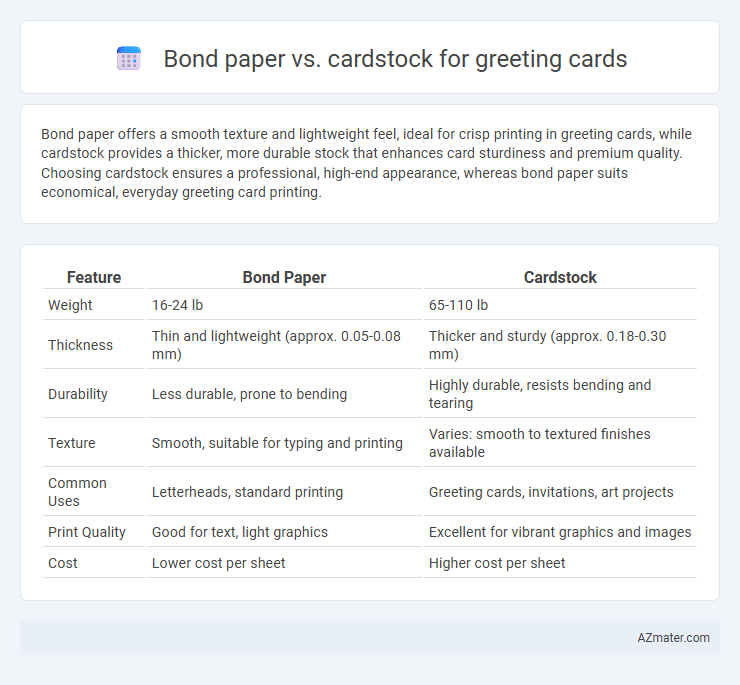Bond paper offers a smooth texture and lightweight feel, ideal for crisp printing in greeting cards, while cardstock provides a thicker, more durable stock that enhances card sturdiness and premium quality. Choosing cardstock ensures a professional, high-end appearance, whereas bond paper suits economical, everyday greeting card printing.
Table of Comparison
| Feature | Bond Paper | Cardstock |
|---|---|---|
| Weight | 16-24 lb | 65-110 lb |
| Thickness | Thin and lightweight (approx. 0.05-0.08 mm) | Thicker and sturdy (approx. 0.18-0.30 mm) |
| Durability | Less durable, prone to bending | Highly durable, resists bending and tearing |
| Texture | Smooth, suitable for typing and printing | Varies: smooth to textured finishes available |
| Common Uses | Letterheads, standard printing | Greeting cards, invitations, art projects |
| Print Quality | Good for text, light graphics | Excellent for vibrant graphics and images |
| Cost | Lower cost per sheet | Higher cost per sheet |
Introduction to Greeting Card Materials
Greeting card materials play a crucial role in the overall feel and durability of the final product, with bond paper and cardstock being the most popular choices. Bond paper is lightweight, smooth, and ideal for printing detailed images and text, offering a professional, polished look. Cardstock is thicker, more rigid, and enhances durability, providing a premium, tactile quality that makes greeting cards stand out.
What is Bond Paper?
Bond paper is a high-quality, durable writing paper commonly used for official documents, letters, and stationery. It is lightweight, typically ranging from 16 to 24 pounds, and has a smooth texture ideal for printing and writing. In greeting card production, bond paper offers flexibility and cost-efficiency but lacks the stiffness and durability of cardstock.
What is Cardstock?
Cardstock is a thick, durable paper known for its rigidity and sturdiness, making it ideal for crafting greeting cards that need to hold shape and withstand handling. It typically ranges from 50 lb to 110 lb weight, providing a substantial feel and professional finish compared to standard bond paper. Its smooth surface adapts well to printing and embellishing, enhancing the visual appeal and tactile experience of greeting cards.
Key Differences Between Bond Paper and Cardstock
Bond paper typically has a lighter weight range of 16-24 lb compared to cardstock's heavier 50-110 lb, making cardstock more durable for greeting cards. Bond paper features a smooth texture and higher opacity, ideal for crisp printing, while cardstock offers a firmer, thicker feel with a variety of finishes including matte, glossy, and textured. The choice between bond paper and cardstock impacts the greeting card's sturdiness, tactile quality, and overall presentation, with cardstock preferred for premium cards and bond paper suited for everyday use.
Durability and Strength Comparison
Cardstock offers superior durability and strength compared to bond paper, making it ideal for greeting cards that require a sturdy, heavy feel. With a higher weight and thicker composition, cardstock resists bending, tearing, and creasing better than bond paper, ensuring the card maintains its shape and appearance over time. Bond paper, being thinner and less rigid, is more prone to damage, which limits its use for durable greeting cards intended to last.
Print Quality and Aesthetic Appeal
Bond paper offers smooth texture and consistent print quality, ideal for detailed text and subtle color gradients in greeting cards. Cardstock provides a thicker, sturdier surface that enhances vibrancy and sharpness of printed designs, contributing to a premium, tactile aesthetic appeal. For greeting cards, cardstock's durability and color saturation generally result in a more professional and visually striking finish compared to bond paper.
Suitability for Different Greeting Card Styles
Bond paper is ideal for greeting cards requiring smooth, professional finishes such as invitations and formal announcements, providing crisp printing and easy folding. Cardstock suits more durable, tactile greeting cards like handmade or pop-up designs, offering sturdiness and a premium feel. Selecting between bond paper and cardstock depends on the desired aesthetic, thickness, and durability specific to the greeting card style.
Cost Considerations: Bond Paper vs Cardstock
Bond paper generally costs less than cardstock, making it a budget-friendly option for producing large quantities of greeting cards. Cardstock, heavier and thicker, carries a higher price point but offers superior durability and a premium feel. Choosing between bond paper and cardstock depends on balancing cost constraints with the desired quality and longevity of the greeting cards.
Environmental Impact and Sustainability
Bond paper typically has a lower environmental impact compared to cardstock due to its thinner composition and often higher recycled content, which reduces resource consumption. Cardstock, while thicker and more durable, generally requires more raw materials and energy to produce, potentially increasing its carbon footprint unless sourced from sustainably managed forests or made from post-consumer recycled fibers. Choosing greeting cards made from FSC-certified or 100% recycled bond paper can significantly enhance sustainability by minimizing deforestation and supporting circular paper use.
Choosing the Best Paper for Your Greeting Cards
Choosing the best paper for your greeting cards depends on the desired durability and texture; bond paper offers a smooth, lightweight option ideal for writing, while cardstock provides a thicker, more rigid feel that enhances the card's longevity and professional appearance. Cardstock's higher GSM (grams per square meter) typically ranges from 200 to 350, making it more suitable for foldable cards that require a sturdy base. For vibrant printing and a premium finish in greeting cards, cardstock is generally preferred over bond paper due to its superior thickness and quality.

Infographic: Bond paper vs Cardstock for Greeting Card
 azmater.com
azmater.com